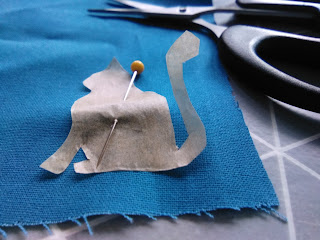Having decided on the fabric, a cotton linen blend, and the main
product: a cushion, it was essential to check the dimensions of the park bench
in Saltaire’s community garden, which would be the final placement for my
product. This would enable me to work out my cushion dimensions and how many I would need.
Above: Diagram of bench
Weather was an important factor, although using natural fabric and digital printing meant I was confident the design would be able to stand up to the elements for the three days of the event. Another important factor was pattern placement. I used www.contrado.com to digitally print my design. This online platform allows you to upload a single design and use software tools to create a repeat pattern and decide on the scale of a single ‘tile’. I also used Photoshop pattern mapping to establish where my pattern would feature in relation to cushions and people’s seating positions. I tried to allow for at least a single row of houses across the centre of each cushion, but this was extremely tricky.
Above: Designing each cushion with one front door, lavender, and one other motif, which would be central on the cushion.
Another fiddly aspect was appliquéing the additional elements onto my
cushions. I used a fusible web backing between the cotton motifs and cushion
fabric. Not confident enough with the sewing machine on such small detail, I
then hand-stitched each motif to secure.
Above: cat motif with fusible web
I found more challenges along the way. I had planned to cross stitch my
alpaca door mat with recycled plastic netting from a punnet of plums. It was
the perfect colour, but once the motifs had been scaled down to match the scale
of the building design, the plastic was just too thick to use in the aida I
had, therefore I had to resort to thread I already had in my collection.
Above: plastic netting and the final cross stitch
Scaling down was also a challenge for the washing line. Previously I had experimented with dolls’ clothes, but the smaller scale meant these were now too big, which meant a rethink. I decided to hand stitch three miniature items of clothing using colours from my colour palette. This worked out okay, but meant additional work to add to my timeframe, and it was very fiddly.
I also decided to utilise a plastic bag, which I had previously corded at college, as the 'washing line' rather than rope or twine, in order to consider how rubbish can be recycled in a positive way.
Above: my stitched miniature clothes and corded, couched 'washing line'.
I had always planned to create patchwork backs to my cushions, inspired
by various community works and the Missoni Home 'patchwork' style discussed in my previous blog here. However, time restraints meant that I decided to stick
to a simpler striped effect, using just three strips of fabric. One of which
was still a colour from my palette and all were fabric cut-offs, scraps, or vintage
napkins for example, so they still fulfilled my demand for sustainability.
Above:
Choosing colour combinations for backing strips, front doors and cats.
Luckily, I tried my
finished product out in its final destination in Saltaire community gardens. As
you can see from the image below, the bench is much wider than my garden
benches and I decided I would need a couple more cushions to complete the
piece. Thankfully I had allowed spare time for this! As shown in the
photograph, my trial run gave me the chance to see my cushions in a downpour. I
was pleased that the design stood out, but I realised that for future projects,
white is probably not a good idea for outdoor use since it shows the slightest
spot of dirt.











Comments
Post a Comment